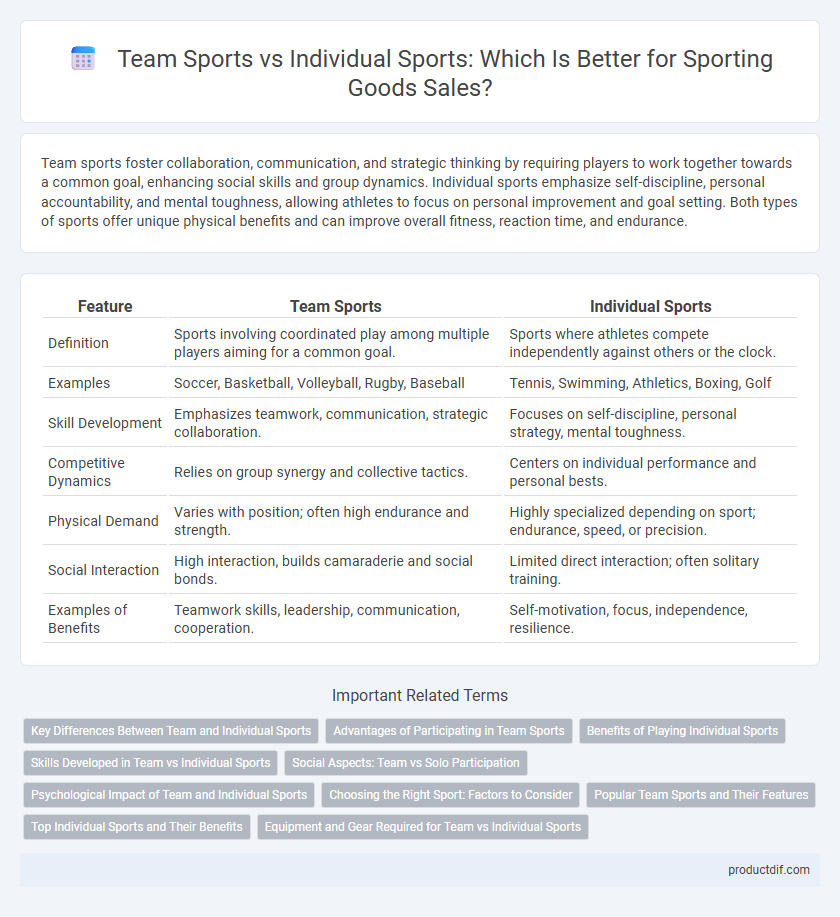Team sports foster collaboration, communication, and strategic thinking by requiring players to work together towards a common goal, enhancing social skills and group dynamics. Individual sports emphasize self-discipline, personal accountability, and mental toughness, allowing athletes to focus on personal improvement and goal setting. Both types of sports offer unique physical benefits and can improve overall fitness, reaction time, and endurance.
Table of Comparison
| Feature | Team Sports | Individual Sports |
|---|---|---|
| Definition | Sports involving coordinated play among multiple players aiming for a common goal. | Sports where athletes compete independently against others or the clock. |
| Examples | Soccer, Basketball, Volleyball, Rugby, Baseball | Tennis, Swimming, Athletics, Boxing, Golf |
| Skill Development | Emphasizes teamwork, communication, strategic collaboration. | Focuses on self-discipline, personal strategy, mental toughness. |
| Competitive Dynamics | Relies on group synergy and collective tactics. | Centers on individual performance and personal bests. |
| Physical Demand | Varies with position; often high endurance and strength. | Highly specialized depending on sport; endurance, speed, or precision. |
| Social Interaction | High interaction, builds camaraderie and social bonds. | Limited direct interaction; often solitary training. |
| Examples of Benefits | Teamwork skills, leadership, communication, cooperation. | Self-motivation, focus, independence, resilience. |
Key Differences Between Team and Individual Sports
Team sports emphasize collaboration, communication, and strategic coordination among players to achieve a common goal, fostering social skills and collective accountability. In contrast, individual sports prioritize personal performance, self-discipline, and mental resilience, with athletes solely responsible for their outcomes. Physical demands vary, as team sports often require dynamic interaction and rapid decision-making, while individual sports focus on precision, endurance, and self-motivation.
Advantages of Participating in Team Sports
Participating in team sports enhances social skills, fosters teamwork, and promotes a sense of community among players. Regular engagement in team activities improves communication, cooperation, and leadership abilities while boosting motivation through collective goals. Team sports also contribute to better mental health by reducing feelings of isolation and encouraging shared responsibility and support.
Benefits of Playing Individual Sports
Playing individual sports significantly enhances self-discipline, as athletes must develop personal training routines and set individual goals to achieve success. These sports also improve mental resilience by requiring constant self-motivation and the ability to stay focused under pressure without relying on teammates. Furthermore, individual sports offer flexible scheduling and personalized skill development, allowing athletes to progress at their own pace while honing specific techniques.
Skills Developed in Team vs Individual Sports
Team sports enhance communication, collaboration, and leadership skills by requiring players to coordinate strategies and work towards a common goal. Individual sports foster self-discipline, focus, and personal accountability, as athletes are solely responsible for their performance and progress. Both types develop physical fitness and mental resilience but emphasize different skill sets crucial for diverse athletic and life challenges.
Social Aspects: Team vs Solo Participation
Team sports foster collaboration, communication, and a strong sense of community, enhancing social bonding and group identity among participants. Individual sports emphasize personal discipline and self-motivation, often attracting athletes who prefer autonomy and individualized goal-setting. Social interaction in team sports contributes to improved teamwork skills and shared experiences, while solo participation prioritizes internal reflection and personal growth.
Psychological Impact of Team and Individual Sports
Team sports promote social interaction, cooperation, and a sense of belonging, which can enhance mental resilience and reduce feelings of isolation. Individual sports foster self-discipline, intrinsic motivation, and personal accountability, leading to improved focus and mental toughness. Both types of sports contribute uniquely to psychological well-being by shaping confidence, stress management, and emotional regulation.
Choosing the Right Sport: Factors to Consider
Selecting the right sport involves evaluating personal goals, skill level, and social preferences. Team sports like soccer or basketball encourage collaboration and communication, while individual sports such as tennis or swimming focus on self-discipline and accountability. Consider factors like physical demands, competitive environment, and available facilities to match the sport with individual motivation and lifestyle.
Popular Team Sports and Their Features
Popular team sports such as soccer, basketball, and volleyball emphasize collaboration, strategic communication, and collective skill execution, fostering a strong sense of camaraderie and shared goals among players. These sports require synchronized teamwork, positional specialization, and dynamic in-game decision-making, which contribute to both physical fitness and social interaction. Key features include defined roles, coordinated tactics, and continuous engagement, making team sports a preferred choice for building leadership and cooperation skills.
Top Individual Sports and Their Benefits
Top individual sports such as tennis, swimming, and athletics provide athletes with personalized training regimes that enhance focus, discipline, and self-motivation. These sports allow participants to set and achieve personal goals, improving mental resilience and physical fitness. Engaging in individual sports often leads to faster skill development and a stronger sense of personal accomplishment compared to team sports.
Equipment and Gear Required for Team vs Individual Sports
Team sports often require a wide range of specialized equipment, including uniforms, protective gear like helmets and pads, and shared items such as balls, nets, and goalposts, designed to accommodate multiple players simultaneously. Individual sports tend to focus on personalized gear tailored to the athlete's specific needs, such as tennis rackets, running shoes, or golf clubs, emphasizing comfort, fit, and individual performance enhancement. The cost and maintenance of equipment in team sports can be higher due to the volume and variety, whereas individual sports gear investment centers on customization and quality.
Team sports vs Individual sports Infographic

 productdif.com
productdif.com